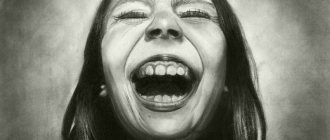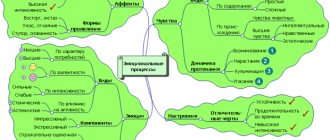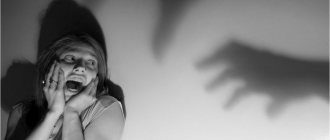hypothesis about the origin and nature of emotions
James–Lange theory
is a hypothesis about the origin and nature of emotions and one of the earliest theories of emotions in modern psychology. It was developed independently by two 19th-century scientists, William James and Carl Lange. The basic premise of the theory is that physiological arousal causes the experience of emotion. [1]Rather than feeling an emotion and a subsequent physiological (bodily) response, the theory suggests that the physiological change is primary and the emotion is then experienced as the brain reacts to information received through the body's nervous system. It suggests that each specific emotion is associated with a unique and different pattern of physiological arousal and emotional behavior in response to an arousing stimulus.
Over time, this theory has been criticized and modified as one of several competing theories of emotion. Modern theorists build on his ideas by suggesting that the experience of emotion is modulated by both physiological feedback and other information, rather than consisting solely of bodily changes, as James proposed. Psychologist Tim Dalglish argues that most modern affective neuroscientists would support such a view. [2] In 2002, a study on the autonomic nervous system said that this theory was "difficult to disprove." [3]
Origin
William James is American. He studied philosophy and psychology.
Karl Lange is a Danish anatomist and physician. Two scientists, independently of each other, at the same time, came to the same conclusions in the field of human emotions.
As a result, James Lange's theory of emotions was formed, which won the minds of many followers. In 1884, Mind magazine published an article by James entitled “What is Emotion?”, where the author shows that when an emotion is cut off from its external manifestations, nothing remains of it. It is worth noting that this hypothesis was quite unexpected and paradoxical for this area of scientific knowledge. William James suggested that the signs that we observe and attribute to the consequences of an emotion are its cause.
Our body reacts to changes in the environment, its conditions and, as a result, reflex physiological reactions unconsciously arise in it.
These include increased secretion of glands, contraction of certain muscle groups and similar manifestations. A signal is sent to the body about all these changes. It is sent directly to the CNS (central nervous system). As a result, emotional experiences are born. This means, as James Lange’s theory of emotions tells us, a person does not cry out of sadness, but on the contrary, he becomes sad as soon as he cries or just frowns.
Theory[edit]
Emotions are often considered judgments about a situation that cause feelings and physiological changes. In 1884, psychologist and philosopher William James proposed that physiological changes actually precede emotions, which are equivalent to our subjective experience of physiological changes and are experienced as feelings. In his words, “our sense of the same changes that are taking place is
emotion". [4] James stated: [5]
If we imagine some strong emotion, and then try to abstract from our consciousness of its all the sensations inherent in its characteristic bodily symptoms, we find that we have nothing left behind, no "mental stuff" of which it can be composed. emotion, and that all that remains is a cold and neutral state of intellectual perception. ... What kind of emotion of fear would remain if there were no feelings of rapid heartbeat, shallow breathing, trembling lips, weakened limbs, goose bumps, or internal stirring - it is completely impossible to think. Is it possible to imagine a state of anger and imagine that it does not boil in the chest, does not flush redness to the face, does not dilate the nostrils, does not clench the teeth, does not have a desire for energetic actions, but instead - relaxed muscles, calm breathing. , and a serene face? On the one hand, the author of this article definitely cannot. The rage completely evaporated, as did the sensation of its so-called manifestations.
Physician Carl Lange independently developed similar ideas in 1885. [2] Both theorists defined emotion as the feeling of physiological changes caused by a stimulus, but the theorists focused on different aspects of emotion. [1] While James did talk about the physiology associated with emotion, he was more focused on conscious emotions and the conscious experience of emotions. For example, a crying person believes that he is sad. Lange reinterpreted James's theory by applying it. He made James's theory more tested and applicable to real-life examples. [6]However, both agreed that if physiological sensations could be eliminated, there would be no emotional experiences. In other words, physiological arousal causes emotions. [1]
According to James, when a person is aware of their body's physiological arousal and emotional behavior, their emotions manifest themselves. He did not believe that common sense reactions were real, but that each emotion produced a specific physiological response. For example, when someone hears glass breaking and thinks that someone is breaking, their heart starts pounding and they shake, James will argue that they are experiencing this physiological reaction because they feel fear or might become a burglar. Or, if a person heard glass breaking and thought it was their roommate being careless and clumsy, their heart would race and their blood pressure would rise due to the target's anger, according to James.
James states that the sequence of events when experiencing emotions is:
Emotional stimulus → Physiological response pattern → Affective experience.
The theory itself emphasizes that physiological arousal, excluding emotional behavior, is the determining factor of emotional feelings. He also emphasizes that each emotional feeling is associated with a unique pattern of physiological responses. It must meet two criteria which include (a) at least two emotions must be evoked and (b) the presence of any emotion must be verified through other measures such as facial expressions or verbal reports. An example would be conducting an experiment to measure happiness and anger. One study measures happiness but provides occasional rewards throughout the experiment, while another study measures anger by asking participants to solve very difficult crossword puzzles. Their physiological responses - blood pressure and electrodermal responses - will be measured. Verbal and facial expressions will also be studied to determine happiness or anger. According to James, the results will show that physiological patterns, blood pressure and electrodermal responses will show different patterns for different emotions.
Further researchers also discovered that there are several specific physiological differences between individual emotions. For example, studies have shown that heart rates are always higher in people experiencing anger and fear than in those experiencing happiness or even sadness. It also shows that blood pressure is also higher in those who experience anger than in those who experience fear, sadness and happiness. It also showed that electrodermal responses were greater in people experiencing fear than during sadness. But there were also cases where the physiological patterns did not differ, which implies that this theory is not 100% accurate and that there was not a unique pattern for each major and individual emotion. This led them to blame the autonomic nervous system, because the autonomic nervous system reacts globally rather than demonstrating these individual responses in an emotion-eliciting situation, and people also typically notice only changes in their autonomic nervous system rather than any specific physiological changes. Which ultimately comes to the conclusion that our own perception of our body's physiological responses does not provide sufficient evidence and evidence to determine the objective nature of an emotional experience.t provide enough evidence and evidence to determine the objective nature of an emotional experience.t provide enough evidence and evidence to determine the objective nature of the emotional experience.[7]
The specific pathway associated with the experience of emotions was also described by James. He stated that the object affects a sense organ, which transmits the information it receives to the cerebral cortex. The brain then sends this information to the muscles and viscera, which causes them to react. Finally, impulses from the muscles and internal organs are sent back to the cortex, transforming the object from “an object merely perceived” to “an object which is felt emotionally.” [1]
James explained that his theory was counterintuitive. For example, while most would think that the order of emotional experiences would be that a person sees a bear, gets scared and runs away, James thought that a person first has a physiological reaction to the bear, such as trembling, and then becomes afraid. and runs. According to James, the physiological reaction comes first, which is perceived as an emotion, and then the reaction follows. [8]
Application of knowledge
If a person wants to have pleasant experiences, he needs to behave as if this has already happened. If you are in a bad mood, then you need to start smiling! You need to train yourself to smile. Only in this way will a person begin to feel like a cheerful person.
The meaning that James Lange's theory of emotions puts into such actions is that a person shapes his environment with his external expressions (smile, frown). Only after this does the environment itself have a certain influence on the person.
It is not difficult to notice that people unconsciously avoid frowning faces. And this is understandable. Each person has enough of his own problems. He doesn't really want to run into strangers. If we see a smile on someone’s face that expresses optimism, then he wins us over and evokes a response in our soul.
Theory of emotions by P.K. Anokhin
Soviet physiologist P.K. Anokhin, in developing his theory, focused on Charles Darwin's theory of evolution. This theory is called the “Biological Theory of Emotions.” According to Anokhin, it turns out that emotional sensations, in the process of evolution, were established as a kind of tool that keeps the process within acceptable boundaries.
Thus, emotions prevent the nature of destruction associated with lack and excess information about certain factors of the life of the body.
In the theory under consideration, emotions are assigned roles aimed at achieving goals:
- Mobilization
- Stimulus
There are two stages:
- Formation of needs
- Satisfying needs
Photo by Kindel Media: Pexels
According to Anokhin's biological theory, needs generate negative emotions as a tool of mobilization, thus helping to satisfy the need in the most optimal way. Positive emotions arise when the desired result is achieved.
An unmet need will result in a feeling of discomfort.
The essence of Anokhin's biological theory
Negative emotions indicate deviations in the internal environment and trigger a specific program of action. After the desired result is achieved, a positive emotion arises. It acts as the final fixing factor. But it should be noted that a positive emotion will arise only when the information from the results of the action taken coincides with the expected result.
A positive emotion, fixed in memory, will subsequently take part in the process of motivation and have an impact on decision-making about how to satisfy a need.
Programmed negative emotions that arise when the result does not coincide with the expected lead to inhibition of ineffective actions and the search for new optimally successful ones aimed at achieving the goal.
Photo by Pavel Danilyuk: Pexels
What strengths did James Lange's theory of emotions show from experiments?
People who participated in the testing process had to evaluate the proposed cartoons and jokes. They held a pencil in their mouth. The point was that some held it with their teeth, and others with their lips. Those who had a pencil in their teeth involuntarily feigned a smile, while others, on the contrary, showed a frown and tension. So, those who had a smile found the proposed cartoons and jokes funnier than the second group.
It turns out that James Lange's peripheral theory of emotions has some basis. It tells us that emotional states are a secondary phenomenon. It manifests itself as awareness of signals coming to the brain that produce changes in internal organs, muscles and blood vessels. In turn, these changes occur at the moment of implementation of a behavioral act, as a consequence of an emotiogenic stimulus.
Theory of emotions P.V. Simonova
Quite an interesting, but at the same time very simple theory from the domestic psychophysiologist, biophysicist and psychologist P. V. Simonov. It's called Information Theory of Emotions. According to Simonov, information theory presupposes clarifications in part of the biological theory of P.K. Anokhina.
The difference between information and biological theories is that it is important not only to have information about the result in the context of achievability/unattainability, but also to know the degree of probability.
The fundamental formula of Simonov's theory
Her idea is as follows:
E = P * (Is-In), where:
- E - emotion.
- P - current need (its strength and quality).
- IS - information about the means that an individual has at the moment.
- In - information about the means that are necessary to satisfy the need.
- Is-In is the probability of satisfying a need, taking into account acquired or genetic experience.
Conclusions according to the formula:
- There will be no emotion if there is a need, but at the same time the person has all the necessary information to satisfy it.
Let's say the need to eat something sweet prompted you to go to the kitchen. You know that a delicious cake is waiting for you there. It is clear that in this case there will be no emotions. You will simply satisfy your need.
- Emotion will arise when there is a need
Giphy
But if, when you go into the kitchen, you see that someone in the family has eaten your cake, or, on the contrary, bought another one, an emotion will appear.
The role of emotions in Simonov's theory
Simonov said that, no matter how paradoxical it may sound, but thanks to emotions, the assessment of the measure of ignorance is ensured. This formula allows you to understand that negative emotions arise due to insufficient information. Positive when there is an abundance of information.
As an example: a negative aftertaste from a vacation due to the fact that expectations did not coincide with reality. That is, expectations were too high, but in reality many “pitfalls” surfaced that were not initially taken into account.
The conclusion is:
- negative emotions are the result of an insufficient amount of information, or unpleasant information (for example, a person is afraid to fly. Cases of plane crashes will be unpleasant information for him);
- positive emotions will arise when there was enough information, or when it turned out to be higher than expected (for example, a vacation trip. In this case, unexpected bonuses in the form of an improved hotel room or additional services provided free of charge by the hotel).
The essence of Simonov's theory is that in normal situations, when a person's behavior is focused on those events that have already occurred, taking into account a clearly defined goal and action plan, he can achieve what he wants without the help of emotions.
But then, when there are many gaps in the situation or a person is faced with something for the first time, another tactic arises regarding satisfying the need. Emotions will be like clues. For example, the emotion of fear arises in the absence of information necessary for protection. Emotions help in searching for new information.
Analysis of emotions using Simonov's formula
P - what do I want?
Ying - how can I achieve this?
Is - what can I do for this?
Photo by Vanessa Bucceri on Unsplash
The main thing to consider is that you need to not only know, but also try to increase your capabilities (Is). Cut off all that unnecessary information about acceptable obstacles that may arise on the way to satisfying the need (In).
Confirmation
Vera Birkenbiel, a German psychologist, suggested that people who took part in experiments, when upset or worried, should retire for a while and try to give a joyful expression to their faces. To do this, you could apply force and force the corners of your lips to rise, and then hold them in this position for 10 to 20 seconds. The psychologist claims that there has never been a case where this forced smile did not develop into a real one.
Thus, the practical application of James Lange's peripheral theory of emotion shows that the kinesthetic cues that trigger emotions are at work.
Criticism[ | ]
Early criticism[ | ]
Since the theory's inception, scientists have found evidence that not all aspects of the theory are relevant or true[4]. This theory was challenged in the 1920s by psychologists named Walter Cannon and Philip Bard, who developed an alternative theory of emotion known as the Cannon-Bard theory, in which physiological changes follow as a result of feelings and emotions. Walter Cannon noted that emotional changes in the human body occur not after physical reactions, but before them.[5] Cannon also emphasized that visceral reactions occur both with and without the experience of many different emotions. For example, the same visceral reactions, such as increased heart rate, sweating, dilated pupils, and the release of adrenaline, can be associated with feelings of fear or anger. However, they are also associated with conditions such as fever, feeling cold, and difficulty breathing. Cannon argued that visceral responses are slow and not sensitive enough to produce an emotional response, that is, there is a long delay between the stimulation of the viscera and the physiological response.
Modern criticism[ | ]
Lisa Feldman Barrett points out that when testing this theory with electrical stimulation, there is no answer and no one-to-one correspondence between behavior and emotion category. “Stimulation of the same area results in different mental responses depending on the person’s prior state as well as the immediate context.”[6] She concludes that there is more of a response occurring when a person feels an emotion than simply physiologically simulating it: some processing must occur between the physiological response and the perception of the emotion.
Barrett also says that experiencing emotions is subjective. There is no way to discern whether a person is feeling sad, angry, or something else without relying on emotion perception. Additionally, people do not always express emotions using the same behavioral patterns. She says emotions are more complex than just physical sensations.
What are the weaknesses of the theory?
The range of human body reactions is more limited than the range of emotional experiences. One organic reaction can be combined with very different feelings. It is known that when the hormone adrenaline is released into the blood, a person becomes excited. However, this excitement can take on different emotional connotations. It depends on external circumstances.
But, according to James Lange's theory of emotions, this is not entirely correct when the emotional state depends on external circumstances. This means that the theory still has weaknesses.
Participants in one experiment, unbeknownst to them, had their blood adrenaline artificially increased. In this test, people were divided into two groups: the first was in a relaxed, fun environment, and the second was in an anxious and depressing atmosphere. As a result, their emotional state manifested itself in different ways: joy and anger, respectively.
It turns out that James Lange's theory of emotions, in short, shows that a person becomes afraid because he trembles. However, it is known that trembling in the body also occurs from anger, sexual arousal and some other factors. Or take, for example, tears - they are a symbol of sadness, anger, grief and, at the same time, joy.
Text of the book “Emotions and Feelings”
Chapter 5 Theories explaining the essence and mechanisms of emotions
V.K. Viliunas is right about (1984, p. 6).
Each of them focuses on one aspect of the problem, thereby considering only a particular case of the occurrence of an emotion or some of its components. The trouble is that theories created in different historical eras do not have continuity. And can there be, in principle, a unified theory for, although related to each other, but still such different emotional phenomena as the emotional tone of sensations, emotions and feelings. Since the time when philosophers and natural scientists began to seriously think about the nature and essence of emotions, two main positions have emerged.
– Scientists occupying one of them, the intellectualist one, most clearly defined by Herbart (1824-1825), argued that organic manifestations of emotions are a consequence of mental phenomena. According to Herbart, emotion is a connection that is established between ideas. Emotion is a mental disorder caused by a mismatch (conflict) between ideas. This affective state involuntarily causes vegetative changes.
– Representatives of another position – sensualists – on the contrary, stated that organic reactions influence mental phenomena. F. Dufour (1883) wrote about this: “Have I not sufficiently proven that the source of our natural tendency to passions does not lie in the soul, but is associated with the ability of the autonomic nervous system to inform the brain about the stimulation it receives, that if we cannot to arbitrarily regulate the functions of blood circulation, digestion, and secretion, it is therefore impossible in this case to explain by our will the violations of these functions that arose under the influence of passions” (p. 388).
These two positions were later developed in cognitive theories of emotions and in the James-Lange peripheral theory of emotions. However, the theoretical consideration of emotions was initiated by Charles Darwin.
5.1. Evolutionary theory of emotions by Charles Darwin
Having published the book “The Expression of Emotions in Man and Animals” in 1872, Charles Darwin showed the evolutionary path of development of emotions and substantiated the origin of their physiological manifestations. Thus, Darwin proved that in the development and manifestation of emotions there is no impassable gap between humans and animals. In particular, he showed that anthropoids and children born blind have much in common in the external expression of emotions. At the same time, he admitted that for the expression of purely human emotions (embarrassment, shame, sadness, indignation), he was unable to find analogues in animals. Thus, with regard to the expression of shame, he wrote that it is not possible that any animal with insufficient mental development could look closely at its appearance and be sensitive to its appearance. Therefore, Darwin wrote, the bashful blush arose at a very late period, in a long series of generations.
Valuable is Darwin's position that there is a direct effect of the nervous system on the expression of emotions, regardless of will and habit. In other words, emotions, according to Darwin, arise reflexively.
The ideas expressed by Darwin were subsequently confirmed. It has been shown that infants, without prior training, react to loud sounds with fear or difficulty breathing (S. Tomkins[11] 11
S. Tomkins, 1962, 1981
[Close]). In addition, some emotions are expressed in the same way in children belonging to different cultures. Darwin's views served as an impetus for the creation of other theories of emotions, in particular the James-Lange peripheral theory.
5.2. “Associative” theory of W. Wundt
W. Wundt's (1880) ideas about the causes of emotions are quite eclectic. On the one hand, he adhered to Herbart’s point of view that, to some extent, ideas influence the emergence of feelings, and on the other hand, he believed that emotions are primarily internal changes, characterized by the direct influence of feelings on the course of ideas.
Wundt considers “bodily” reactions only as a consequence of feelings. According to Wundt, facial expressions arose initially in connection with elementary sensations, as a reflection of the emotional tone of sensations; higher, more complex feelings (emotions) developed later. However, when some kind of emotion arises in a person’s consciousness, it each time evokes by association a lower feeling or sensation that is similar in content to it. It is this that causes those facial movements that correspond to the emotional tone of sensations. So, for example, facial expressions of contempt (pushing the lower lip forward) are similar to the movement when a person spits out something unpleasant that has fallen into his mouth.
5.3. Peripheral James–Lange theory
American psychologist W. James (1884) put forward a peripheral theory of emotions, based on the fact that emotions are associated with certain physiological reactions, which were discussed earlier. He wrote: “It is usually expressed as follows: we have lost our fortune, are sad and cry; we meet a bear, are frightened and take flight; we are offended by the enemy, enraged and strike him. According to the hypothesis I am defending, the order of events should be somewhat different, namely: the first mental state is not immediately replaced by the second. Between them there must be bodily manifestations. And therefore the most rational way to express it is this: we are sad because we cry; enraged because we beat another; We are afraid because we are trembling. (...) If bodily manifestations did not immediately follow perception, then the latter would be in form a purely cognitive act, pale, devoid of color and emotional warmth. We might then see a bear and decide that it would be best to flee, we might suffer an insult and find it fair to repulse the blow, but we would not feel fear or indignation” (1991, p. 275).
Independently of W. James, the Danish pathologist G. Lange published a work in 1895 in which he expressed similar thoughts. But if for the first organic changes were reduced to visceral (internal organs), then for the second they were predominantly vasomotor. Joy, from his point of view, is a combination of two phenomena: increased motor innervation and dilation of blood vessels. This is where the expressive expression of this emotion comes from: fast, strong movements, loud speech, laughter. Sadness, on the contrary, is a consequence of weakening motor innervation and narrowing of blood vessels. Hence the sluggish, slow movements, weakness and soundlessness of the voice, relaxation and silence. Lange reduced his theory to the following scheme.
Weakening of motor innervation – ················································································································································································································ disappointment
Weakening of motor innervation + vasoconstriction········· sadness
+ vasoconstriction + spasms of organic muscles
innervation + coordination disorder
+ spasms of organic muscles
Increased motor innervation + organic muscle spasms + dilation of blood vessels·········· joy
Increased motor innervation + organic muscle spasms + dilation of blood vessels + coordination disorder
From the perspective of the James-Lange theory, the act of occurrence of emotion is as follows:
stimulus =>
occurrence of physiological changes
=>
=>signals about these changes to the brain
=>
=>emotion (emotional experience).
The meaning of this paradoxical statement is that an arbitrary change in facial expressions and pantomimes leads to the involuntary appearance of the corresponding emotion. Portray anger - and you yourself will begin to experience this feeling; start laughing - and you will feel funny; try to walk in the morning, barely dragging your feet, with your arms down, your back bent and a sad expression on your face - and your mood will really deteriorate. On the other hand, suppress the outward manifestation of an emotion and it will disappear.[12] 12
Similar thoughts regarding the mechanism of the emergence of emotions were expressed by Aristotle.
[Close]
W. James did not always provide indisputable evidence for his hypothesis. For example, he describes the story of an acquaintance who experienced fear during seizures associated with difficulty in taking a deep breath, and considers this proof that the emotion here is simply a sensation of a bodily state and its cause is a purely physiological process. However, the appearance of fear in the described case can be explained in another way: when a person experienced difficulty in inhaling , he was afraid
that he would suffocate, and it was precisely the consciousness of this that caused him to experience fear.
You can object to me: if I say that a person was afraid, then this means that he was already afraid, that is, he experienced fear. But fear is most often just a probabilistic forecast, a person’s assessment of a future event. And it is precisely in connection with this unfavorable prognosis for the life of the subject, i.e., a mental process, and not a physiological one, that an emotion arises in him (and not necessarily fear, it can also be anxiety), leading not only to the experience of danger, but also to physiological response to it. Thus, there is no identity between fear as a forecast and fear as an emotion.
In line with the James-Lange theory, G. Münsterberg also understood the mechanism of the emergence of emotions. Considering the role of the teacher in raising children and, in particular, in managing their emotional sphere, he strongly opposed the position of the teacher as a passive observer of the emotional life of children, powerless to intervene in the process programmed by nature. “If feelings really represented what vulgar psychology is inclined to see in them, then it would inevitably seem a hopeless task to try to exercise and educate them. Artificially give them one form or another. The teacher would be forced to play the role of a passive spectator and wait for natural development, writes Münsterberg. – What could he do in order to change the responses born in the soul, since, thanks to the device given by nature, precisely this or that wave of organic excitation spreads through the nervous system? He could no more prevent the taste of sugar from being pleasant and the taste of fish oil from causing pleasure than he could prevent the grass from being green and the sky from being blue. In this case, there would be no possibility, no means to master feeling. (...) The teacher would have to admit that although he can force or convince a child to swallow disgusting fish oil, despite the unpleasantness of this action, he is still unable to turn displeasure into pleasure. The usual view of feelings causes the teacher, if he thinks about it, to fall into a discouraging pessimism. The most important factor in inner life seems to be beyond his control. He must simply wait for changes. (...) He can only wait with folded hands. And how the perspective changes if the teacher recognizes the presence of a motor element in every feeling and understands that the feeling itself is a consequence of the reaction! (...) Convince the child to take the unpleasant medicine with a laughing face and with a wide stretch of the whole body, so that he opens his eyes wide and stretches out his arms - in a word, try to artificially recreate all those movements that would express great pleasure. If the child thus opens wide the avenues for performing those movements which are the opposite of the involuntary reaction, and if he repeats this experience with some persistence and energy, the unpleasant medicine will very soon lose its disgustingness and become indifferent" (1997, pp. 202-203) .
So, according to Münsterberg, feelings (the emotional tone of sensations discussed in his statement cited earlier) are a person’s reaction to the received impression (sensation), which is prolonged or interrupted through movements. But from this correct postulate a completely illogical conclusion follows: “Thus, the group of muscular sensations that accompany general expansion appears in our self-consciousness as pleasure, and the sensations from contraction as displeasure” (ibid., p. 199). Hence the simple solution to the question: if you want an object to be pleasant, move closer to it, and if you want it to be unpleasant, move away from it, since “a stimulus is pleasant because, perceiving it, we notice that we are approaching” (p. 197). “When we use the sensations that we get from these actions of approaching and moving away in order to grasp the stimulus that moves us, then they appear to us simply as expressions of “pleasantness” and “unpleasantness”” (p. 196).
In general, it should be noted that it is difficult to fully understand Münsterberg’s views on emotions. Attaching an exaggerated importance to motor reactions, he at the same time expresses thoughts that contradict the “peripheral” theory of James-Lange: “Even less should we draw ourselves a caricature of the stated view, imagining that purely external behavior can completely change a deeply embedded emotion or feeling.” (p. 205) or: “We can experience the emotion of sadness even if we smile to hide it...” (p. 205). “...In such cases, an external smile can even exacerbate the feeling of contrast with internal displeasure. If we artificially change these internal reactions, then we actually influence the emotion itself” (ibid., p. 206). It is difficult to understand what “internal reactions” or motor elements of sensations we are talking about. If Münsterberg means “motor discharges,” this is one thing, if expression (facial expressions, pantomime) is another, and if the motor actions of approaching or moving away from an emotiogenic object are third. Still, it seems that most often by motor emotional reactions he means “disposition to action,” i.e., what is commonly called urge
to action.
J. Watson (Watson, 1930), the main representative of behaviorism, for whom all behavior was built on the principle of “stimulus-response” and therefore all introspection was “psychologizing”, criticizing the James-Lange theory, wrote that in accordance with it the best way studying emotions would be to freeze at the moment they arise and begin introspection. However, in his criticism, I think he went too far, believing that it is impossible to scientifically study emotions.
Russian psychologist N. N. Lange (1914) believed that this theory confuses sensory sensations and emotions themselves.
We can agree that the James-Lange theory has many weaknesses and does not explain all cases of emotional response. Its significant drawback, in my opinion, is the unnatural appearance of emotions. In fact, why should I cry for no reason and thereby put myself in a sad mood? Or why should I laugh for no reason in order to become cheerful? In short, why do I always need to play some kind of role as an artist? The emergence of emotions is biologically expedient: the tension that has arisen is discharged, the body’s energy resources are mobilized, etc. It is this expediency that the James–Lange theory does not explain. Moreover, she simply ignores her.
E. Claparède (1928) tried to reconcile the “classical” theory (perception – emotion – experience of emotion – organic reactions) with the “peripheral” theory. To do this, between the perception of a dangerous situation and the emotion of fear, he introduced a “sense of danger,” which is a reflection of the motor attitude that preceded it. As a result, the entire chain of unfolding events takes on the following form:
perception => escape mindset => sense of danger =>
=> organic reactions => emotion (fear).
He supports his scheme with the following argument: life observations indicate that the emotion of fear follows a feeling of danger when a person is unable to escape or protect himself. Here it must be added that fear also arises when a dangerous situation, due to chance or a person’s actions, ended happily, but the person begins to realize how it all could have ended.
E. Claparède believes that in cases where an emotion arises suddenly, for example, when we are frightened by an unexpected and loud sound, the James-Lange theory retains its full meaning in its usual form. It seems to me that he expressed a reasonable thought: it is only because of the biased and unjustified unified interpretation of emotions that the classical and “peripheral” theories of emotions seem irreconcilable. It is enough to abandon the attitude to emotions as processes occurring according to some single pattern, and then one class of emotions can be explained from the position of classical theories, and another class from the position of a “peripheral” theory.
Indeed, it is quite strange that critics of the “peripheral” theory of emotions for some reason do not notice that it realistically explains the emergence of the emotional tone of sensations
.
After all, one cannot seriously believe that the experience of pleasant or unpleasant appears before a receptor reaction to a particular stimulus occurs, or before difficulty breathing or muscle stiffness appears, i.e., before a physiological reaction appears [13] 13
It should be noted that there are supporters of this point of view. G. Coghill (1929) and K. Herrick (Herrick, 1956) develop views according to which emotions are phylogenetically and ontogenetically an earlier form of reflection than sensations. Such primitive emotions are closely associated with movements aimed at increasing contact with a beneficial object or reducing contact with a harmful object. Among domestic psychologists, this concept is adhered to by K. K. Platonov (1972); he writes that elementary analyzers in the simplest animals initially gave only two subjectively captured qualitative signals: “vitally useful” and “vitally harmful.” They were two elementary experiences, which later took the form of pleasure and displeasure. In such an elementary form, emotions are almost no different from the simplest need as a reflection of the need for something. The experience of need becomes an effective trigger for a biologically appropriate motor reaction. At the same time, emotions were the basis on which sensations developed as a higher type of reflection, giving a subjective image of the objective world. With the development of sensations, emotions also improved, but still continue to remain polar to ugly experiences.
[Close]. For example, a feeling of discomfort (negative emotional tone) during prolonged breath-holding occurs due to a sharp drop in oxygen content in the blood. Another negative emotional tone - an unpleasant, painful feeling of fatigue (discomfort) during physical work - is a consequence of physico-chemical changes in the muscles, increased breathing, etc., and not physiological changes due to the appearance of a feeling of fatigue. Among Russian psychologists, the idea that organic changes play a role in the development of certain emotional states was defended by S. L. Rubinstein.
Another fact that critics of W. James do not pay any attention to is that by physiological changes he also understood psychomotor changes (expression), in particular facial expressions (hence - sad because we cry).
The result of the discussions was mutual concessions. Opponents of this theory recognized that bodily manifestations of emotions influence the emotion itself, giving it new strength and intensity, and W. James, in later expositions of his theory, admitted that feelings of suffering and pleasure can cause bodily changes, that is, they precede them. In addition, James changed his view on the mechanism of the appearance of bodily changes. If earlier he believed that they appear as a simple unconditioned reflex reaction of the body to an external stimulus, then later he attributed these changes to more complex forms of motor reactions. These reactions involve awareness of the meaning that an external impression has for a person. The latter is “understood” by a person, is for him the “subject” of emotional experience, that is, it comes from the highest centers of behavior control.
5.4. Cannon–Bard theory
Experiments carried out by physiologists at the end of the 19th century with the destruction of structures that conduct somatosensory and viscerosensory information to the brain gave rise to C. Sherrington (Sherrington, 1900) to conclude that vegetative manifestations of emotions are secondary in relation to their cerebral component, expressed by the mental state. The James–Lange theory was sharply criticized by the physiologist W. Cannon (Cannon, 1927), and he also had reasons for this. Thus, even if all physiological manifestations were excluded in the experiment (by cutting the nerve pathways between the internal organs and the cerebral cortex), the subjective experience was still preserved. Physiological changes occur in many emotions as a secondary adaptive phenomenon, for example, to mobilize the body’s reserve capabilities in the event of danger and the fear it generates, or as a form of release of tension that has arisen in the central nervous system.
Cannon noted two things. Firstly, the physiological changes that occur during different emotions are very similar to each other and do not reflect their qualitative originality. Secondly, these physiological changes unfold slowly, while emotional experiences arise quickly, that is, they precede the physiological reaction.
He also showed that artificially induced physiological changes (injection of adrenaline), characteristic of certain strong emotions (pre-race excitement), do not always cause the expected emotional behavior. From Cannon's point of view, emotions arise as a result of a specific reaction of the central nervous system and, in particular, the thalamus.
Thus, according to Cannon, the diagram of the stages of the emergence of emotions and the physiological changes accompanying them looks like this:
stimulus => excitation of the thalamus => emotion => physiological changes.
In later studies by P. Bard (Bard, 1934a, b) it was shown that emotional experiences and the physiological changes that accompany them arise almost simultaneously. Thus, the diagram takes on a slightly different form:
The views of Cannon and Bard were combined into the Cannon-Bard theory of emotions, according to which the stimulus that gives rise to emotion simultaneously causes two reactions - awakening and experiencing emotions, which do not cause each other. Thus, this theory speaks of the independence of physiological and mental emotional reactions. However, modern theories of emotion reject such independence.
Traditions of countries
Often emotional expressions are determined by cultural norms. If we take a country like Japan into consideration, we can see that the manifestation of pain and sadness in the presence of persons of a higher position is a manifestation of disrespect. In this regard, when a Japanese person is reprimanded by a superior, he should listen to him with a smile. In Slavic countries, such behavior of a subordinate is considered insolence.
In China, too, it is not customary to bother higher-ranking, honorable persons with your grief. It has long been customary there to inform a person older in age and position about your misfortune with a smile in order to downplay the significance of grief. But the people of the Andaman Islands, according to their traditions, cry after a long separation when the meeting takes place. They also react to reconciliation after quarrels.
Notes[ | ]
- Cannon, Walter (December 1927). "The James-Lange Theory of Emotions: A Critical Examination and an Alternative Theory". The American Journal of Psychology. 39: 106–124.
- W. James “What is Emotion”
- Dalgleish, T. (2004). "The emotional brain" (PDF). Nature Reviews Neuroscience. 5 (7): 583–589.
- Cannon, Walter (December 1927). "The James-Lange Theory of Emotions: A Critical Examination and an Alternative Theory". The American Journal of Psychology. 39: 106—124
- Dalgleish, T. (2004). "The emotional brain" (PDF). Nature Reviews Neuroscience. 5 (7): 583–589.
- Feldman Barrett, Lisa (2012). "Emotions are Real." American Psychological Association.
Criticism
It turns out that James Lange's peripheral theory of emotions, in short, doesn't quite work. Although, of course, psychologists use it in their practice. The result is usually most often positive. However, they always have to take into account a person's origins, cultural heritage and habitat.
This theory shows the ability to control emotions and inner feelings. A person is really capable, given a certain mood, of performing actions characteristic of one or another inner feeling. In this way he evokes the feelings themselves.
This theory was criticized by physiologists: Sherrington C.S., Cannon W. and others. They were based on data obtained in experiments with animals, which indicated that the same peripheral changes occur under different emotions and conditions not related to emotions. Vygotsky L.S. also criticized this theory due to the contrast between elementary (lower) emotions and true human experiences (higher, aesthetic, intellectual, moral).
K. Izard's theory of emotions
It's called the Theory of Differential Emotions. Developed by American psychologist and specialist in the field of emotional psychology Carroll Izard. This theory got its name by focusing on those emotions that are considered as different experiential and motivational processes.
Photo by Kelvin Yan on Unsplash
This theory gives emotions the functions of determinants of behavior with a wide range: from violence and manslaughter to self-sacrifice.
According to Izard, the emergence of emotions occurred as a result of biological evolution, differing on three central grounds:
- biological factors in the performance of mental activity;
- pantomime and facial expressions;
- the specificity of the experiences that a person experiences.
Based on the above, Izard identified ten basic emotions, which are the foundation of the human motivational system. They include:
- Joy
- Sadness
- Astonishment
- Interest
- Guilt
- Contempt
- Disgust
- Anger
- Fear
- Shame
Communication and all kinds of processes of combinations of these basic emotions generate all other emotions.











